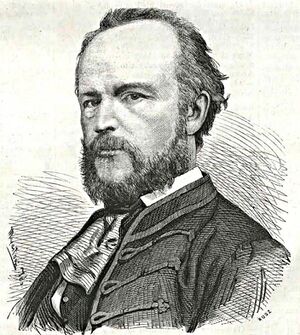مور تان
- الصيغة الأصلية لهذا الاسم الشخصي هي Than Mór. هذه المقالة تستخدم الترتيب الغربي للأسماء.
Mór Than | |
|---|---|
 Contemporaneous etching of Mór Than, by Károly Rusz | |
| وُلِدَ | 19 يونيو 1828 |
| توفي | 11 مارس 1899 (aged 70) |
| الجنسية | Hungarian |
Mór Than (مجرية: [ˈtɒn ˈmoːr]; 19 June 1828 – 11 March 1899) was a Hungarian painter. He painted in the Realist school and worked with several high-profile Hungarian and Austrian painters of his time. He travelled around Italy, in France and his native Hungary. Later in life, he worked for several museums and galleries in Hungary.
Biography
Born at Óbecse (today Bečej, Serbia) to his father János Than of Abbot (1789–1858), a royal treasurer, and mother Ottilia Setényi.[1] He attended high school in Kalocsa, in present-day Hungary and then studied philosophy and law in the current-day Budapest. He became a student of painting under Miklós Barabás.
His studies were interrupted, and during the 1848 revolution he became a war painter alongside Arthur Görgei. Later, due to illness, he was not conscripted into the imperial army. As a lawyer, he drew an entire album filled with objects drawn from Hungarian history, and after the conflict, he pursued an artistic career. He traveled to Vienna, where he continued his studies under Austrian painter, Karl Rahl. In 1855, he traveled to Paris and then travelled back to Italy. Eventually he returned home in the early 1860s and opened a studio.[2]
From 1864 he worked alongside Károly Lotz on the murals of the Vigadó of Pest, and from 1875, he created the murals of the stairwell of the Hungarian National Museum together with Lotz.[3][4]
In 1885, he moved to Italy, and then returned to Hungary in 1890, from which, between 1890 and 1896, he became the guardian of the gallery of the National Museum, and, in 1896, he briefly became the director of the National Gallery (before the foundation of the Museum of Fine Arts). He died in Trieste in 1899.[5]
Legacy
He was a Realist painter who worked in the pre-Impressionist style. His subjects were mostly historic events and portraits but also mythological or fantasy themes. He painted frescos which decorate several prominent public buildings in Budapest.
Than also designed the first Hungarian postage stamp, which was supposed to be distributed after the Hungarian Revolution.[6] However, the uprising failed, and the Hungarian State led by Lajos Kossuth collapsed; the printing presses were subsequently destroyed by Austrian authorities.
معرض صور

"حين أسدل المساء أستاره، أضيئت المشاعل، وتقدم اثنان من البرابرة إلى أتيلا وأنشدا أغانٍ ألّفاها، للإشادة بانتصاراته وعظيم أفعاله في الحرب. وحملق المحتفلون في الشعراء، وبعضهم انطرب بالأشعار، وشارك في الغناء، وآخرون انفعلت قلوبهم بذكر الحروب، بينما آخرون انخرطوا في بكاء ونحيب—أولئك الذين وهنت أجسادهم بفعل الزمن وتاقت أرواحهم للراحة.
Battle of Tápióbicske، مرسومة في 1849–1850
The Assassination of Karađorđe (1863), المتحف الوطني لصربيا
وليمة أتيلا (1870)، في المعرض الوطني المجري، بوداپست
پورتريه إگناتس زملڤايس (1884)، في جامعة زملڤايس، بوداپست
إمرأة شابة ترتدي رداءً من عصر النهضة، 1886 (مجموعة خاصة)
References
- ^ "familysearch.org apáthi Than János gyászjelentése". FamilySearch.
- ^ "Than Mór". Keiselbach Galéria és Aukciósház. Retrieved 2011-05-10.[dead link]
- ^ "Art of Mór Than (1823-1899)". www.hung-art.hu. Retrieved 1 May 2022.
- ^ "Hungarian National Museum - Museums in Buapest". Panorama Tours (in الإنجليزية). Retrieved 1 May 2022.
- ^ "Than Mór". sulinet.hu. Retrieved 10 May 2011.
- ^ Visnyovszki, Gábor (1996). Stamps. Budapest: Állami Nyomda. p. 85.
External links
 Media related to مور تان at Wikimedia Commons
Media related to مور تان at Wikimedia Commons
خطأ لوا في وحدة:Authority_control على السطر 278: attempt to call field '_showMessage' (a nil value).






